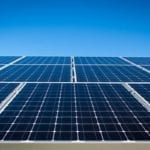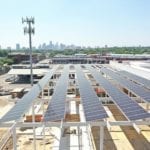An analysis of federal labor data for the clean energy sector shows renewable energy and other industries are adding jobs after months of declines brought on by the coronavirus pandemic. But the gains in July were lower than those in June, signaling sectors such as solar, wind, energy storage, energy efficiency, and electric vehicles continue to struggle amid the COVID-19 outbreak.
The American Council on Renewable Energy (ACORE), Environmental Entrepreneurs (E2), and other clean energy advocacy groups responded to a report from BW Research Partnership released August 12 that showed clean energy industries added 3,200 jobs in July, a far cry from the more than 106,000 jobs added in June. The groups, though, said the sectors’ combined unemployment is still about 15% below the levels from earlier this year, prior to pandemic-induced lockdowns that resulted in more than 620,000 lost jobs in the clean energy sector at the peak of job losses in May.
Job losses began mounting in March as the pandemic began to impact the U.S. A May report showed more than a half-million jobs had been lost in the sector in March and April.
Groups continue to say congressional action is needed to spur a rebound for clean energy industries and the wider economy as a whole. Pre-pandemic, the clean energy sector employed 3.4 million workers in the U.S. Clean energy encompasses wind and solar installers, energy efficiency companies, and electric vehicle production.
“What is needed most right now is temporary refundability of renewable tax credits so projects can continue to move forward despite an increasingly constrained tax equity market, and a delay in the scheduled phase-down of existing tax credits,” said Gregory Wetstone, president and CEO of ACORE, in a statement in response to the report. “The renewable sector’s modest job gains in June have stalled out and are at risk of reversing again.”
“While the rest of the world is doubling down on clean energy to jump-start their economies, our country’s leaders are sitting around watching these jobs disappear,” said Bob Keefe, executive director of E2, in a statement. “Study after study—as well as history—shows investing in clean energy is the best and fastest way to build back our economy. Why doesn’t Congress get it—and do something?”
15 Years to Recover Lost Jobs
“At the current pace, it would take nearly 15 years to recover the clean energy jobs lost since February,” the BW Research Partnership’s report said. ACORE and other groups want Congress to make existing tax credits for wind, solar, and other projects refundable now, in order to provide projects with funding that is needed to leverage investment.
“The job recovery in the clean energy sector has stalled. While July brought new jobs to some parts of the U.S. economy, clean energy has a long way to go to regain the more than 500,000 jobs lost since February,” said Phil Jordan, vice president and principal at BW Research Partnership.
“July’s analysis is cause for grave concern,” said Pat Stanton, policy director for E4TheFuture. “Clean energy workers in every American county are eager to help our economy recover while contributing to cleaner air. Investing in clean energy today can bring economic, environmental, and equity benefits that will last for decades. Let’s get these workers back on the job now.”
California added 720 clean energy sector jobs in July, the most among states. Colorado, Florida, Illinois, Massachusetts, Michigan, New York, North Carolina, and Texas each added more than 100 jobs last month.
The Bureau of Labor Statistics said the U.S. added 1.8 million jobs in July, with unemployment at 10.2%, based on 16.3 million unemployed workers.
Some Projects Continuing
There are clean energy projects continuing amid the pandemic. Construction is underway on five new solar projects in Northeast Florida (Figure 1), part of Florida Power & Light’s 30-by-30 plan to install 30 million solar panels in the state by 2030. The utility has said those projects will create 500 permanent jobs, with about 1,200 construction jobs available during the build-out. The solar farms are expected to be completed by year-end.

Duke Energy recently announced its 200-MW Holstein Solar project in Texas is now online. Duke Energy acquired the project from developer 8minute Solar Energy. The project is 8minute’s first completed installation in Texas, where the company has four other projects in development, totaling about 1 GW of generation capacity. 8minute has said those projects will create more than 1,000 construction jobs, and another 2,000 indirect jobs.
Renewable Properties, a developer and investor in small-scale utility and community solar energy projects, on August 13 said it has begun construction on the Silveira Ranch Solar Project, the largest community solar array in Marin County, California. The project will supply Marin Clean Energy (MCE), California’s first Community Choice Aggregation Program, with 3 MW of solar-produced electricity.
Kate Sears, Marin County Third District Supervisor and Board Chair of MCE, said in a news release that a key element of the project is that, “Knowing the concerns around COVID-19 and the economy, these solar projects will not only provide necessary upgrades to our aging grid infrastructure and reduce our dependence on traditional energy sources, but also keep local crews employed in outdoor physically-distanced working conditions when unemployment rates are climbing.”
More Jobs in Energy Efficiency
The BW Research report released Wednesday said most of July’s job growth came in energy efficiency, though the 2,100 jobs added last month represent just a 0.1% overall gain for the sector. Nearly 358,000 jobs have been lost in the energy efficiency industry, about 15% of the sector’s total workforce.
The report also noted racial discrepancies, saying “Black and Hispanic workers continue to feel disproportionately high levels of unemployment, and while white workers have seen slight job growth over the past month, Black workers saw no change.”
The partnership’s report is an analysis of the Labor Department’s Aug. 7 jobs report, which shows a historically high pace for U.S. weekly unemployment claims, and a continued rise in both long-term and permanent unemployment rates. The report looked at Bureau of Labor Statistics data for both June and July, along with the weekly unemployment summaries from the Labor Department. The report was co-commissioned by E2, E4TheFuture, and ACORE.
The report said about 590 jobs were added in the renewable energy power generation sector, and said nearly 82,000 renewable energy workers—about 14% of the sector’s total workforce—are still unemployed due to the pandemic.
—Darrell Proctor is associate editor for POWER (@DarrellProctor1, @POWERmagazine).










